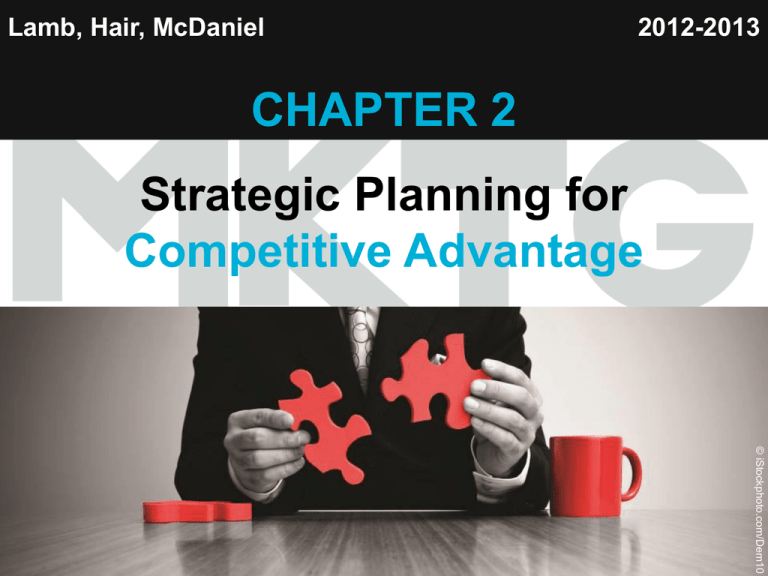
Lamb, Hair, McDaniel
2012-2013
CHAPTER 2
Copyright ©2012 by Cengage Learning Inc. All rights reserved
11
© iStockphoto.com/Dem10
Chapter 1
© AP IMAGES/JENNIFER GRAYLOCK
Strategic Planning for
Competitive Advantage
Learning Outcomes
1
Understand the importance of strategic planning
2
Define strategic business units (SBUs)
3
Identify strategic alternatives and know a basic
outline for a marketing plan
4
Develop an appropriate business mission statement
5
Describe the components of a situation analysis
6
Identify sources of competitive advantage
2
Learning Outcomes
7
Explain the criteria for stating good marketing
objectives
8
Discuss target market strategies
9
Describe the elements of the marketing mix
10
Explain why implementation, evaluation, and control
of the marketing plan are necessary
11
Identify several techniques that help make strategic
planning effective
3
Strategic Planning is…
the managerial process of
creating and maintaining a fit
between the organization’s
objectives and resources and the
evolving market opportunities.
The GOAL of strategic planning is long-term
profitability and growth.
4
© 2013 by Cengage Learning Inc. All Rights Reserved.
1
Characteristics of
Strategic Business Units (SBUs)
An SBU HAS…
A distinct mission and specific
target market
Control over its resources
Its own competitors
Plans independent of other SBUs
5
© 2013 by Cengage Learning Inc. All Rights Reserved.
2
Ansoff’s Opportunity Matrix
Market
Penetration
6
Increase market share among
existing customers
Market
Development
Attract new customers to
existing products
Product
Development
Create new products for
present markets
Diversification
Introduce new products
into new markets
© 2013 by Cengage Learning Inc. All Rights Reserved.
3
Boston Consulting Group
Portfolio Matrix
Star
Cash Cow
Portfolio
Matrix
Question Mark
Dog
7
© 2013 by Cengage Learning Inc. All Rights Reserved.
3
Portfolio Matrix Strategies
Build
Hold
Harvest
Divest
8
© 2013 by Cengage Learning Inc. All Rights Reserved.
3
What Is a Marketing Plan?
Planning – the process of anticipating future events and
determining strategies to achieve organizational objectives in
the future.
Marketing Planning – designing activities relating to
marketing objectives and the changing marketing
environment.
Marketing Plan – a written document that acts as a guidebook
of marketing activities for the marketing manager.
9
© 2013 by Cengage Learning Inc. All Rights Reserved.
3
Why Write a Marketing Plan?
Provides a basis for comparison of actual and expected
performance
Provides clearly stated activities to work toward common
goals
Provides an examination of the marketing environment
Serves as a reference for the success of future activities
Allows entry into the marketplace with awareness
10
© 2013 by Cengage Learning Inc. All Rights Reserved.
3
Components of a SWOT Analysis
Examining internal strengths and weaknesses.
Focus on organizational resources:
• Production costs
• Marketing skills
• Financial resources
• Company or brand image
• Employee capabilities
• Technology
11
© 2013 by Cengage Learning Inc. All Rights Reserved.
5
Environmental Scanning
Helps identify opportunities and threats.
Designing a marketing strategy is based
on six major environmental forces:
• Social
• Economic
• Technological
• Political/Legal
• Competitive
12
© 2013 by Cengage Learning Inc. All Rights Reserved.
5
© AP IMAGES/PRNEWSFOTO/PEPSICO
• Demographic
Cost Competitive
Advantage
Obtain inexpensive raw materials
Create efficient scale of plant operations
Design products for ease of manufacture
Control overhead costs
Avoid marginal customers
13
© 2013 by Cengage Learning Inc. All Rights Reserved.
6
Niche Competitive
Advantage
Used by small companies with limited
resources
May be used in a limited geographic market
14
© 2013 by Cengage Learning Inc. All Rights Reserved.
6
Building Sustainable
Competitive Advantage
Sustainable competitive advantage is an
advantage that cannot be copied by the
competition.
A firm that has successfully achieved a
competitive advantage will stake out a
position unique in some manner from its
rivals.
15
© 2013 by Cengage Learning Inc. All Rights Reserved.
6
Marketing Objectives
Realistic
Measurable
Time specific
Compared to a benchmark
“Our objective is to achieve 10
percent dollar market share in
the cat food market within 12
months of product introduction.”
16
© 2013 by Cengage Learning Inc. All Rights Reserved.
7
Describing the Target Market
Marketing Strategy
involves…
the activities of selecting and describing one or more
target markets and developing and maintaining a
marketing mix that will produce mutually satisfying
exchanges with target markets.
Marketing Opportunity Analysis
(MOA) involves…
the description and estimation of the size and sales
potential of market segments that are of interest to
the firm and the assessment of key competitors in
these market segments.
17
© 2013 by Cengage Learning Inc. All Rights Reserved.
8
The Marketing Mix is…
a unique blend of product, place (distribution),
promotion, and pricing strategies designed to
produce mutually satisfying exchanges with a
target market.
The elements of the marketing mix
are often referred to as the
“Four Ps”
18
© 2013 by Cengage Learning Inc. All Rights Reserved.
9
Following Up on
the Marketing Plan
Implementation
Evaluation and Control
Marketing audit is…
19
© 2013 by Cengage Learning Inc. All Rights Reserved.
10
Techniques for Effective Strategic
Planning
Continual
attention
Creativity
Management
commitment
Effective
Strategic
Planning
20
© 2013 by Cengage Learning Inc. All Rights Reserved.
11




